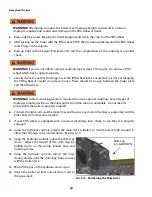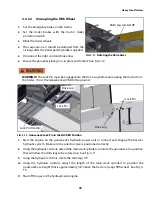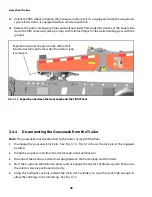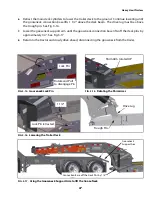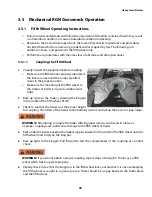
Heavy Haul Trailers
48
3.9
Operating Precautions
3.9.1
Loading and Unloading Methods
The purpose of the this document is not to instruct the operator about driving nor is it to advise on or
dictate load securement procedures. The information is of a general nature and is intended to
provide an experienced, professional operator with some basic information.
In order to ensure safe and stable loading and unloading, the trailer must be on level and firm ground,
have the trailer brakes engaged and the trailer wheels chocked. Never place any part of your body
beneath the trailer of near any moving parts while loading or unloading.
3.9.2
Pre-Trip Inspection
Refer to the Pre-Operation Trailer Inspection (Section 3.3) before transporting the trailer. All
equipment must be properly maintained and regularly inspected to ensure the safest possible
operation.
3.9.3
Safe Loading Limitations
Overloading a vehicle must NEVER be permitted. Do not exceed the rated capacity of the trailer or
tractor. Roadways also have weight limits, depending on their construction and the time of year.
Overloading can cause road damage, inadequate braking capacity, tire, suspension and/or frame
damage or failure, and lose of vehicle control.
3.9.4
Speed
Do not exceed maximum highway speed limits, loaded or unloaded. With long or high center of
gravity loads, vehicle stability is reduced,
SLOW DOWN.
3.9.5
Load Securement
Improperly secure loads can shift or even fall off the trailer, resulting in probable damage to the trailer
or cargo and possible lose of vehicle control. Adequate load securement is the responsibility of the
operator. Follow the National Safety Code Standard 10 Cargo Securement regulations.
Visual inspection of the fifth wheel is required to confirm it is locked to the kingpin before moving the
vehicle. Inspect the fifth wheel mountings for any sign of failure or damage to load bearing
components. Inadequate greasing of the fifth wheel can cause rough turning, as the upper coupler
and the fifth wheel plate will not slide smoothly across one another.
3.9.6
Dimensions
Familiarize yourself with the dimensions of your equipment before attempting to load. The
approximate width, height and weight should be known to properly load the trailer.
Summary of Contents for H550 Series
Page 2: ......
Page 4: ...Heavy Haul Trailers ...
Page 15: ...Heavy Haul Trailers 8 ...
Page 30: ...21 Heavy Haul Trailers ...
Page 31: ...Heavy Haul Trailers 22 Both Sides ...
Page 32: ...23 Heavy Haul Trailers Both Sides ...
Page 52: ...43 Heavy Haul Trailers 3 5 4 Extension Load Shim Instructions ...
Page 59: ...Heavy Haul Trailers 50 ...
Page 84: ...69 Heavy Haul Trailers Date Maintenance Performed Maintenance Records ...
Page 85: ...Heavy Haul Trailers 70 Date Maintenance Performed Maintenance Records ...
Page 86: ...71 Heavy Haul Trailers Date Maintenance Performed Maintenance Records ...
Page 87: ...Heavy Haul Trailers 72 Date Maintenance Performed Maintenance Records ...
Page 88: ......

